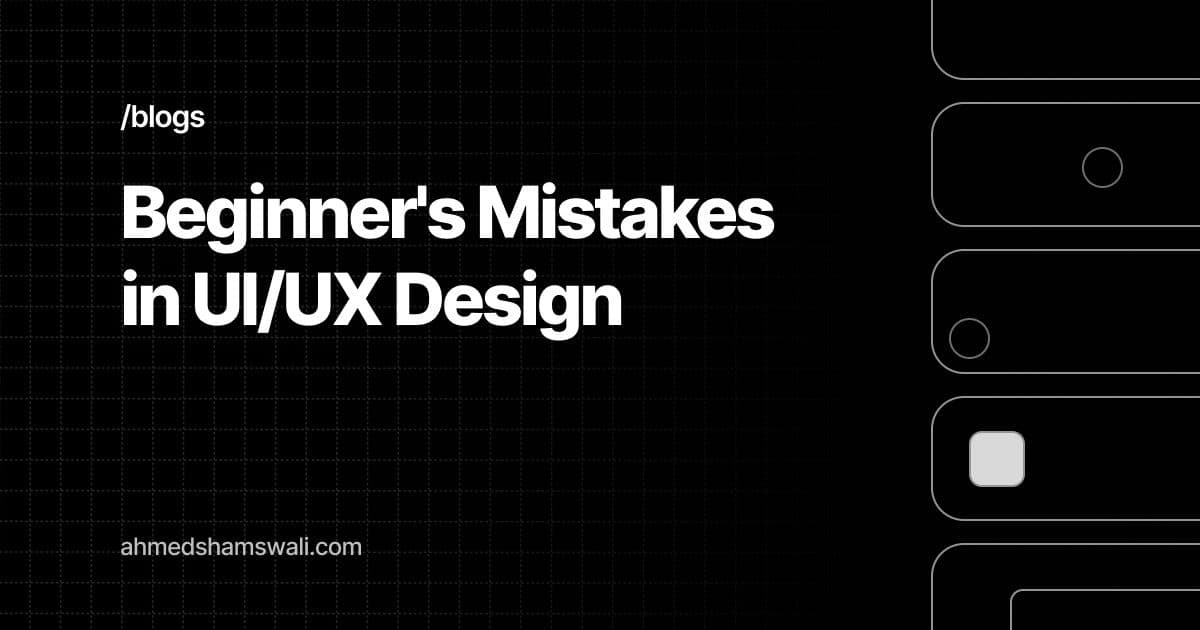Beginner's Mistakes in UI/UX Design

My Journey
When I first dipped my toes into the world of UI/UX design, I had no idea what I was getting into. I thought, "It's just making things look pretty, right?" Oh, how wrong I was. UI/UX isn't just about aesthetics; it's about crafting experiences, shaping interactions, and, ultimately, making people's lives easier. If you're just starting out, I know how overwhelming it can be. The terminology, the tools, the endless debates over whether to use a hamburger menu or a bottom navigation bar—it’s a lot. But don’t worry, I’ve got you. Let’s walk through everything you need to know to become confident in UI/UX design.
UI vs. UX – What’s the Difference?
First things first, UI and UX are not the same thing, but they’re inseparable. UI (User Interface) is all about what users see—buttons, typography, colors, and layouts. UX (User Experience) is how users feel while interacting with a product. Good UI gets people in the door, but good UX keeps them there. You need both, like peanut butter and jelly. Or coffee and Monday mornings.
My First UI/UX Mistakes
I remember my first project. I was obsessed with making the interface beautiful—sleek buttons, trendy fonts, flashy animations. It looked great, but using it? A nightmare. Buttons were in awkward places, navigation was confusing, and the users had no idea what to do. That was my first hard lesson: beauty means nothing if the experience is frustrating.
The Power of Usability
So, where do you start? Let’s talk about usability because, trust me, it’s everything. A well-designed product should be intuitive. Think about your favorite apps—the ones you use every day without even thinking. They just make sense. That’s not an accident. Designers spend hours crafting experiences that feel effortless. As a beginner, your job is to learn how to do the same.
One of the biggest mistakes I made in the beginning was assuming users think like designers. Spoiler alert: they don’t. Users don’t care about your creative genius; they just want to accomplish their goals with as little effort as possible. Your job is to remove friction. If a user has to stop and think, "Wait, how do I do this?"—you've already lost them.
Learning from Real Users
Here’s a quick exercise: grab your phone and open an app you use all the time. Pay attention to how you interact with it. Where do your eyes go first? How many taps does it take to complete an action? Now, open an app you rarely use. Does it feel just as intuitive? Probably not. That’s the difference between good and bad UX.
The Magic of Visual Hierarchy
Let’s talk about hierarchy because, honestly, it’s a game-changer. Everything on a screen is fighting for attention, and your job is to decide what wins. Size, color, contrast—these all help guide users' eyes to what matters most. I once designed a sign-up screen where the "Skip" button was almost as prominent as the "Sign Up" button. Guess what happened? Everyone skipped. Lesson learned: prioritize actions visually.
Typography – More Than Just Pretty Fonts
Typography is another silent MVP. I used to think picking fonts was just about making things look stylish, but typography affects readability, accessibility, and even emotion. Ever tried reading long blocks of text in an all-caps font? It feels like being yelled at. Don’t do that to your users.
Accessibility – Designing for Everyone
Speaking of accessibility—if you ignore it, you're not just alienating users, you're failing as a designer. Contrast ratios, font sizes, keyboard navigation—all of these make a huge difference. A beautifully designed app that only works for some people isn’t a good design.
Why You Need to Test Your Designs
And then there’s user testing. If you take one thing from this entire guide, let it be this: you are not your user. I used to skip testing because I assumed I knew best. Big mistake. The only way to truly know if your design works is to watch real users interact with it. The insights you get from testing are gold. You’ll see them struggle with things you thought were obvious, and that’s where the real learning happens.
The Heart of UI/UX Design
UI/UX design isn’t just about making things look good—it’s about making things work, making them feel effortless, and making users feel like they belong. It’s psychology, art, problem-solving, and a little bit of magic all rolled into one. And trust me, once you get the hang of it, it’s one of the most satisfying things you can do.
If you’re still here, you’re already on the right path. Keep designing, keep testing, and most importantly—keep putting yourself in the user’s shoes. That’s the secret to great UI/UX.
all rights reserved by @ahmedshamswali.